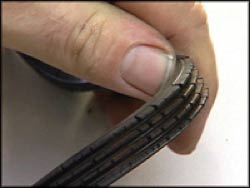Serpentine Belt
A broken belt is always bad news! When a belt breaks that means the water pump quits circulating coolant through the engine, the alternator quits charging the battery, the power steering pump ceases to assist steering, and the air conditioner quits cooling. Many newer vehicles have a single serpentine belt that drives all of the engine’s accessories, so when it fails everything stops working.
Every time a belt passes around a pulley, it bends and flexes. This produces heat combined with age hardens the rubber and then the belt can start to fray or pile and become damaged to the point of failure.
Ten out of ten serpentine belt failures end up causing a breakdown! That’s because the belt controls vital components to engine life and run ability!
The good news is that replacing the belts periodically can go a long way towards minimizing the risk of a breakdown caused by belt failure. After all, it’s a lot easier to replace a belt at your convenience than having the belt fail unexpectedly.
For optimum protection, most experts recommend replacing belts every three to four years, or every 30,000 to 48,000 miles
Symptoms that may be the result of aging belts include:
- Belt squeal, when the A/C compressor is turned on or hard Power Steering turns.
- A battery that keeps running down (due to belt slippage).
- Startup squeal tension related.

Cracks in a belt indicate that it is getting ready to fail and should be replaced.
Service Interval recommendation
Refer to your owners manual for service intervals or ask a Lube Express technician for your vehicles manufactures recommended service intervals.
Service Time
15 to 20 Minutes
